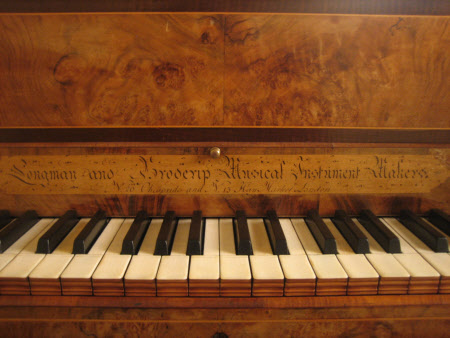Harpsichord
Category
Musical instruments, devices and recordings
Date
1783
Materials
ivory, maplewood, brass, boxwood, ebony, mahogany and leather
Order this imageCollection
Fenton House, London
NT 1448929
Summary
Harpsichord, by Thomas Culliford, England, 1783. A single-manual harpsichord inscribed on the fascia batten Longman & Broderip Musical Instument (sic) Makers / No. 26 Cheapside and No. 13 The Haymarket London. Inscribed on the reverse of the fascia batten Tho.s Culliford Maker, Fountain Court Cheapside / London, March, 1783 (a further similar inscription appears on the keywell baseboards). The case veneered with mahogany and walnut, inlaid with plain lines, and resting on a later stand (a post-WWII stand). Furnished with one lid prop-stick and a detachable ‘fallboard’. Keyboard compass FF (less FF#) – f3, disposition 2x8' with later pedal-operated buff (‘harp’) stop. This harpsichord was probably the one described by George Henry Benton Fletcher (1866-1944) thus: 'my first purchase was a harpsichord hidden under a couple of heavy armchairs in a second-hand shop' (The Listener, 1938).
Provenance
Harpsichord, made by Thomas Culliford for the retailer Longman & Broderip, 1783. Purchased by George Henry Benton Fletcher (1866-1944) in a 'country pawn shop, found under a stack of chairs' (Amateur Musician, 1939). Described in the Old Devonshire House catalogue 1938 and in Amateur Musician 1939. Transferred to the National Trust in February 1938.
Marks and inscriptions
LONGMAN AND BRODERIP, MUSICAL INSTRUMENT MAKERS, No. 26 CHEAPSIDE AND No. 13 HAYMARKET, LONDON

